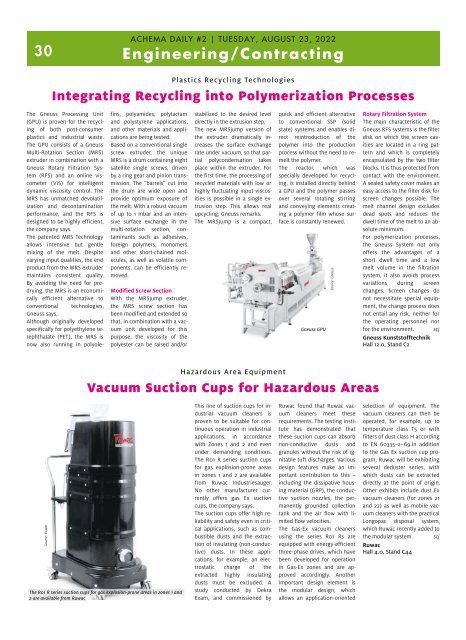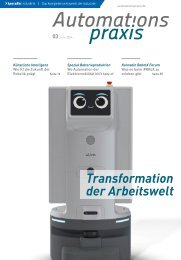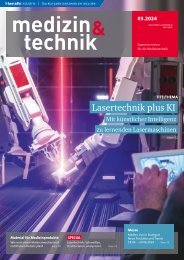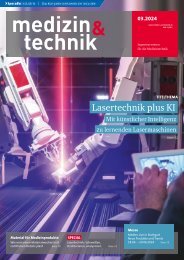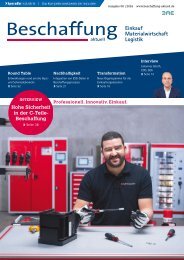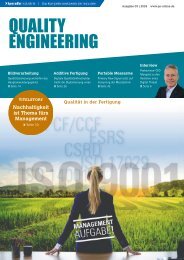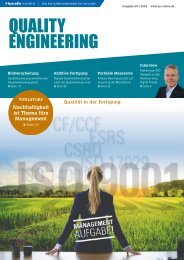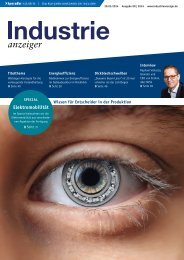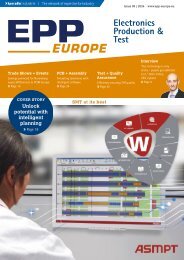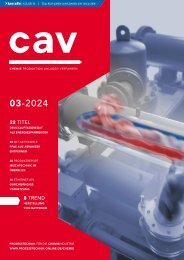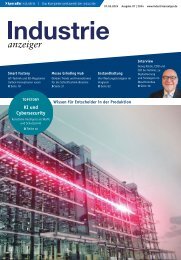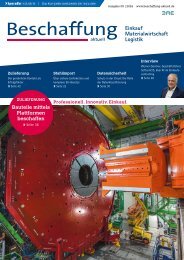ACHEMA Daily 2022 #2
Erfolgreiche ePaper selbst erstellen
Machen Sie aus Ihren PDF Publikationen ein blätterbares Flipbook mit unserer einzigartigen Google optimierten e-Paper Software.
30<br />
<strong>ACHEMA</strong> DAILY <strong>#2</strong> | TUESDAY, AUGUST 23, <strong>2022</strong><br />
Engineering/Contracting<br />
Plastics Recycling Technologies<br />
Integrating Recycling into Polymerization Processes<br />
The Gneuss Processing Unit<br />
(GPU) is proven for the recycl -<br />
ing of both post-consumer<br />
plastics and industrial waste.<br />
The GPU consists of a Gneuss<br />
Multi-Rotation Section (MRS)<br />
extruder in combination with a<br />
Gneuss Rotary Filtration System<br />
(RFS) and an online viscometer<br />
(VIS) for intelligent<br />
dynamic viscosity control. The<br />
MRS has unmatched devolatilization<br />
and decontamination<br />
performance, and the RFS is<br />
designed to be highly efficient,<br />
the company says.<br />
The patented MRS Technology<br />
allows intensive but gentle<br />
mixing of the melt. Despite<br />
varying input qualities, the end<br />
product from the MRS extruder<br />
maintains consistent quality.<br />
By avoiding the need for predrying,<br />
the MRS is an economically<br />
efficient alternative to<br />
conventional technologies,<br />
Gneuss says.<br />
Although originally developed<br />
specifically for polyethylene terephthalate<br />
(PET), the MRS is<br />
now also running in polyolefins,<br />
polyamides, polylactam<br />
and polystyrene applications,<br />
and other materials and applications<br />
are being tested.<br />
Based on a conventional single<br />
screw extruder, the unique<br />
MRS is a drum containing eight<br />
satellite single screws, driven<br />
by a ring gear and pinion transmission.<br />
The “barrels” cut into<br />
the drum are wide open and<br />
provide optimum exposure of<br />
the melt. With a robust vacuum<br />
of up to 1 mbar and an intensive<br />
surface exchange in the<br />
multi-rotation section, contaminants<br />
such as adhesives,<br />
foreign polymers, monomers<br />
and other short-chained molecules,<br />
as well as volatile components,<br />
can be efficiently removed.<br />
Modified Screw Section<br />
With the MRSjump extruder,<br />
the MRS screw section has<br />
been modified and extended so<br />
that, in combination with a vacuum<br />
unit developed for this<br />
purpose, the viscosity of the<br />
polyester can be raised and/or<br />
stabilized to the desired level<br />
directly in the extrusion step.<br />
The new MRSjump version of<br />
the extruder dramatically increases<br />
the surface exchange<br />
rate under vacuum, so that partial<br />
polycondensation takes<br />
place within the extruder. For<br />
the first time, the processing of<br />
recycled materials with low or<br />
highly fluctuating input viscosities<br />
is possible in a single extrusion<br />
step. This allows real<br />
upcycling, Gneuss remarks.<br />
The MRSJump is a compact,<br />
quick and efficient alternative<br />
to conventional SSP (solid<br />
state) systems and enables direct<br />
reintroduction of the<br />
polymer into the production<br />
process without the need to remelt<br />
the polymer.<br />
The reactor, which was<br />
specially developed for recycl -<br />
ing, is installed directly behind<br />
a GPU and the polymer passes<br />
over several rotating stirring<br />
and conveying elements creating<br />
a polymer film whose surface<br />
is constantly renewed.<br />
Gneuss GPU<br />
Source: Gneuss<br />
Rotary Filtration System<br />
The main characteristic of the<br />
Gneuss RFS systems is the filter<br />
disk on which the screen cavities<br />
are located in a ring pattern<br />
and which is completely<br />
encapsulated by the two filter<br />
blocks. It is thus protected from<br />
contact with the environment.<br />
A sealed safety cover makes an<br />
easy access to the filter disk for<br />
screen changes possible. The<br />
melt channel design excludes<br />
dead spots and reduces the<br />
dwell time of the melt to an absolute<br />
minimum.<br />
For polymerization processes,<br />
the Gneuss System not only<br />
offers the advantages of a<br />
short dwell time and a low<br />
melt volume in the filtration<br />
system, it also avoids process<br />
variations during screen<br />
changes. Screen changes do<br />
not necessitate special equipment,<br />
the change process does<br />
not entail any risk, neither for<br />
the operating personnel nor<br />
for the environment. scj<br />
Gneuss Kunststofftechnik<br />
Hall 12.0, Stand C2<br />
Hazardous Area Equipment<br />
Vacuum Suction Cups for Hazardous Areas<br />
Source: Ruwac<br />
The R01 R series suction cups for gas explosion-prone areas in zones 1 and<br />
2 are available from Ruwac<br />
This line of suction cups for industrial<br />
vacuum cleaners is<br />
proven to be suitable for continuous<br />
operation in industrial<br />
applications, in accordance<br />
with Zones 1 and 2 and even<br />
under demanding conditions.<br />
The R01 R series suction cups<br />
for gas explosion-prone areas<br />
in zones 1 and 2 are available<br />
from Ruwac Industriesauger.<br />
No other manufacturer currently<br />
offers gas Ex suction<br />
cups, the company says.<br />
The suction cups offer high reliability<br />
and safety even in critical<br />
applications, such as combustible<br />
dusts and the extraction<br />
of insulating (non-conductive)<br />
dusts. In these applications,<br />
for example, an electrostatic<br />
charge of the<br />
extracted highly insulating<br />
dusts must be excluded. A<br />
study conducted by Dekra<br />
Exam, and commissioned by<br />
Ruwac found that Ruwac vacuum<br />
cleaners meet these<br />
requirements. The testing institute<br />
has demonstrated that<br />
these suction cups can absorb<br />
non-conductive dusts and<br />
granules without the risk of ignitable<br />
tuft discharges. Various<br />
design features make an important<br />
contribution to this –<br />
including the dissipative housing<br />
material (GRP), the conductive<br />
suction nozzles, the permanently<br />
grounded collection<br />
tank and the air flow with limited<br />
flow velocities.<br />
The Gas-Ex vacuum cleaners<br />
using the series R01 Rs are<br />
equipped with energy-efficient<br />
three-phase drives, which have<br />
been developed for operation<br />
in Gas-Ex zones and are approved<br />
accordingly. Another<br />
important design element is<br />
the modular design, which<br />
allows an application-oriented<br />
selection of equipment. The<br />
vacuum cleaners can then be<br />
operated, for example, up to<br />
temperature class T5 or with<br />
filters of dust class H according<br />
to EN 60335–2–69.In addition<br />
to the Gas Ex suction cup program,<br />
Ruwac will be exhibiting<br />
several deduster series, with<br />
which dusts can be extracted<br />
directly at the point of origin.<br />
Other exhibits include dust Ex<br />
vacuum cleaners (for zones 21<br />
and 22) as well as mobile vacuum<br />
cleaners with the practical<br />
Longopac disposal system,<br />
which Ruwac recently added to<br />
the modular system. scj<br />
Ruwac<br />
Hall 4.0, Stand C44


